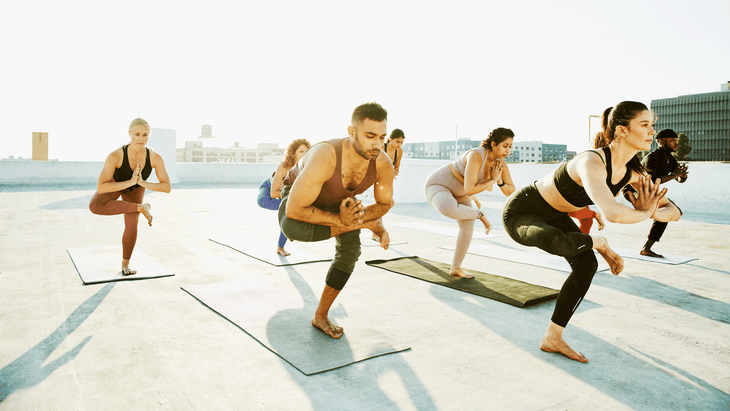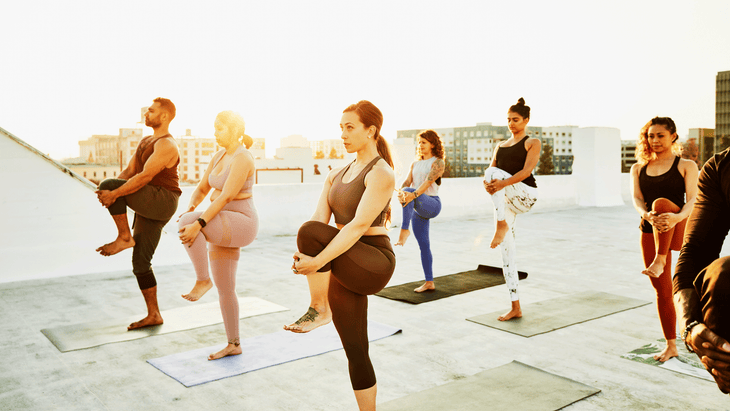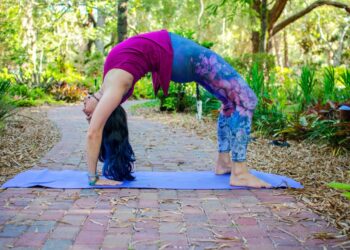“], “filter”: { “nextExceptions”: “img, blockquote, div”, “nextContainsExceptions”: “img, blockquote, a.btn, a.o-button”} }”>
Heading out the door? Learn this text on the brand new Exterior+ app obtainable now on iOS units for members!
>”,”title”:”in-content-cta”,”sort”:”hyperlink”}}”>Obtain the app.
Whether or not you’re simply getting began with yoga or years into your apply, you’ve in all probability skilled a standard conundrum: you suppose you might want to be higher at yoga stability poses earlier than you are able to do them however doing yoga stability poses is the way you turn into higher at them. It’s rather a lot like if you’re making use of for a job and also you want expertise to land the gig however you want the gig to get expertise.
Very similar to how one can volunteer or land an internship to realize the wanted expertise, you possibly can apply balancing in yoga whereas nonetheless bettering your stability. You merely want to permit your self somewhat time to develop your abilities. The next techniques can improve your steadiness in yoga, whether or not you are feeling like you might topple simply coming to standing on the entrance of the mat or want to carry one leg to the aspect with out trying.
10 Methods to Keep Regular in Yoga Stability Poses
Whether or not each ft are on the mat in a standing pose otherwise you’re balancing on one foot, the next ideas may also help remind.
1. Focus On Your Basis
Yoga academics generally inform college students to “floor into the mat,” however in case you’re new to yoga, it’s possible you’ll be uncertain what this even means not to mention know the right way to apply it.
The cue primarily means which you could’t construct a steady constructing with a shoddy basis. If you wish to stand on one or each legs in a yoga pose with out toppling over, you might want to discover a robust base of assist. This begins with all the time being conscious of the factors of connection between your physique and the mat. In different phrases, meaning take note of your ft.
Extra particularly, attempt to isolate the precise factors in your ft which can be urgent downward into the mat. Take into consideration rising deep lengthy roots from the bottom of every toe, the ball of every foot beneath the massive toe, and the heels into the mat. On the identical time, gently carry your arches to allow them to assume the form of their pure curvature.
By visualizing the precise factors of contact between your physique and the mat, you’re higher capable of give attention to the sensations between your physique and the mat. This, in flip, helps you are feeling extra steady and supported, even if you wobble whereas attempting to carry any standing yoga pose the place each ft are on the mat however staggered otherwise you’re balancing on one leg.
By attempting to visualise the precise factors of contact between your physique and the mat, you’re higher capable of give attention to the sensations of your physique being supported by the mat within the crucial locations.
2. Ditch the Socks and Sneakers
Sustaining your sense of bodily stability requires advanced interactions between quite a few methods in your physique, together with visible enter from the eyes, the vestibular system positioned within the inside ear, and tactile suggestions out of your level of reference to the bottom.
In the event you’re going to focus in your basis, you have got to have the ability to really feel what’s beneath you. Training yoga in your naked ft permits all the tactile receptors on the soles of your ft to have most publicity to the mat with out socks or sneakers blocking that enter.
3. Hook up with Your Basis
After you’ve created a robust connection between your physique and the mat, you’re prepared to maneuver your consideration upward. Consider your physique as a set of interconnected beams. Beginning out of your basis, or ft, think about organising every beam sequentially within the correct place.
For instance, if you’re standing in Tree Pose, give attention to standing tall together with your shin vertical and stack your joints in order that your knee is true over your ankle.
Then, proceed upward to the thigh, conserving your leg upright and your joints stacked reasonably than leaning off to the aspect. The crest of each hip bones needs to be on the identical peak reasonably than one slouching decrease than the opposite.
In the event you’re standing upright, your backbone needs to be straight together with your shoulders stacked over your hips. Lastly, take into consideration drawing the crown of your head towards the sky. Think about a bunch of helium balloons related to the highest of your head and lifting you towards the ceiling.
4. Use Your Muscle groups
We regularly consider standing as a passive course of by which we depend on our bones and joints to maintain us upright. However standing yoga poses ought to by no means be passive, notably in case you’re attempting to enhance your stability. One of the best ways to search out and maintain alignment in a pose is to contract your muscle mass.
Meaning participating the small intrinsic muscle mass of the ft to assist as you unfold your toes broad and carry your arches. It additionally means activating the smaller stabilizing muscle mass within the shins and calves in addition to the quads and hamstrings. And interesting the muscle mass of your core—together with the again, glutes, and pelvic flooring—can contribute in shocking methods to your steadiness. You be taught to interact these muscle mass as you proceed to apply yoga with self-awareness. It merely takes time and expertise. One easy technique to have interaction your core is to push by means of your heel—each in your standing leg and your lifted leg.

5. Use Your Gaze to Stabilize
The most effective suggestions for bettering stability for yoga is to repair your gaze on a stationary level straight forward. In yoga, this method known as drishti, which implies regular and concentrated consideration.
For instance, if you’re in Prolonged Hand-to-Huge Toe Pose or Low Lunge and end up teetering, select one thing immovable straight forward in your line of imaginative and prescient, akin to a spot on the wall, and maintain your eyes glued to it.
This retains the visible enter coming into your physique fixed and may also help regular the fluid within the inside ear canal, which is liable for detecting modifications within the vestibular system.
6. Use Your (Complete) Core
We already mentioned the truth that any yoga balancing pose requires the lively engagement of your muscle mass to keep up correct alignment. Nevertheless, it’s useful to reemphasize the significance of participating your entire core—together with the again and glutes—that will help you stability. Holding the belly and decrease again muscle mass good and tight helps your backbone and pelvis in a steady place. This can enhance the steadiness of your total physique.
7. Breathe
When you get right into a balancing yoga pose, join together with your breath. Gradual your inhalations and exhalations and maintain your focus in your breath. This may also help you keep current within the pose reasonably than fascinated by different issues. That targeted consideration in your physique will assist you to preserve your alignment and stability. It should additionally prepare you to maintain your focus throughout troublesome moments in life.
8. Depend on Coaching Wheels
Do not forget that internship analogy earlier? There’s completely nothing unsuitable with utilizing assist, whether or not you’re nonetheless studying yoga stability poses or are merely experiencing an off day. Whether or not you’re working towards at dwelling or at a studio, place your physique close to a wall or chair so as to evenly maintain on or attain out for assist if you begin to wobble.
9. Take Your Ft Wider
It’s regular to really feel somewhat unsteady in standing poses by which your ft are grounded, akin to Mountain Pose. Attempt spacing your ft somewhat wider aside so that they’re hip-distance aside as a substitute of touching to extend your base of assist. Discover your stability right here.
Then strive standing postures by which each ft are on the mat however they’re staggered, akin to Excessive Lunge and Warrior 2. In the event you really feel wobbly, as soon as once more take your ft wider aside. Lecturers usually cue you to behave as in case you’re standing on railroad tracks and never a tightrope. That’s good recommendation.

10. Begin Small
You don’t have to leap proper into Warrior 3, Dancer Pose, or some other single-leg yoga stability poses. You’ll be able to work on all the earlier ideas—fascinated by your basis, discovering your physique alignment, actively participating your muscle mass, focusing your gaze, and utilizing your breath that will help you really feel steady and balanced—in any standing pose, together with these with each ft touching the mat.
Begin with primary standing postures that require each ft to be on the mat. Perhaps you construct up towards more difficult yoga balances poses by first drawing one knee towards your chest and steadying your self right here.
Then discover some one-legged stability poses and make sure to give your self grace and persistence together with your yoga apply. As with something you be taught, discovering steadiness in yoga stability poses doesn’t dramatically occur in a single day. Nevertheless, sticking together with your yoga routine will assist you to develop the self-awareness and balancing abilities essential to slowly and steadily evolve your yoga apply.












